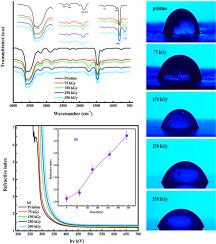伽马辐射诱导定制超高分子量聚乙烯的结构、光学、表面和机械性能
IF 3.3
3区 工程技术
Q1 NUCLEAR SCIENCE & TECHNOLOGY
引用次数: 0
摘要
本研究考察了伽马辐射如何影响超高分子量聚乙烯(UHMWPE)的机械、光学、表面和结构特性。对超高分子量聚乙烯样品施加了 75、150、250 和 350 kGy 的不同伽马剂量。物理和化学特性的研究涉及多种光谱技术,包括傅立叶变换红外光谱、X 射线衍射、机械特性变化和生物相容性特性。傅立叶变换红外光谱分析显示,辐照聚合物会形成新的波段,这一过程与辐照聚合物链的氧化和二氧化碳的产生有关。根据 XRD 图谱,辐照样品的结晶度随着伽马辐射的增加而增加。光学分析结果表明,辐照样品的光学特性有所改善。与原始样品相比,辐照样品的吸收光谱显示出吸收边缘向高波长值移动。另一方面,随着伽马射线辐射剂量的增加,光吸收边沿呈上升趋势。随着伽马射线剂量的增加,吸收边缘会向长波长方向移动。接触角的测量结果表明,表面自由能随着伽马射线照射剂量的增加而上升。详细介绍了如何测量辐照超高分子量聚乙烯样品的机械性能。机械性能测量结果表明,机械性能在一定程度上与剂量有关。此外,随着伽马剂量的增加,辐照超高分子量聚乙烯的硬度也会增加。本文章由计算机程序翻译,如有差异,请以英文原文为准。

Gamma radiation induced tailoring the structural, optical, surface and mechanical properties of UHMWPE
The present investigation examined how the resultant gamma radiation affected the ultra-high molecular weight polyethylene's (UHMWPE) mechanical, optical, surface, and structural characteristics. Different gamma doses of 75, 150, 250, and 350 kGy were applied to the UHMWPE samples. The study of physical and chemical qualities has involved a variety of spectroscopy techniques, including Fourier Transform Infrared spectroscopy, X-ray diffraction, mechanical property changes, and biocompatibility properties. New bands are formed, as indicated by FT-IR analysis, and this process is linked to the oxidation of irradiation polymer chains and the production of carbon dioxide. The crystallinity of irradiated samples increases as the gamma radiation increases, according to XRD patterns. The analyzed optical results exhibit improvements in the optical characteristics of the irradiated samples. The absorbance spectra of the irradiated samples showed a shift toward the high of wavelength values in the absorption edge as compared to the pristine sample. On the other hand, the optical absorption edge has an increasing tendency as the dose of gamma-ray radiation is increased. As the gamma-ray dose increases, the absorption edge moves toward the longer wavelength. The measurements of the contact angle indicate that the surface free energy rises with increasing gamma irradiation. It was detailed how the mechanical properties of the irradiated UHMWPE samples were measured. The mechanical measurements indicate that the mechanical properties are dose-dependent to some extent. Furthermore, as gamma doses rise, so does the hardness of irradiated UHMWPE.
求助全文
通过发布文献求助,成功后即可免费获取论文全文。
去求助
来源期刊

Progress in Nuclear Energy
工程技术-核科学技术
CiteScore
5.30
自引率
14.80%
发文量
331
审稿时长
3.5 months
期刊介绍:
Progress in Nuclear Energy is an international review journal covering all aspects of nuclear science and engineering. In keeping with the maturity of nuclear power, articles on safety, siting and environmental problems are encouraged, as are those associated with economics and fuel management. However, basic physics and engineering will remain an important aspect of the editorial policy. Articles published are either of a review nature or present new material in more depth. They are aimed at researchers and technically-oriented managers working in the nuclear energy field.
Please note the following:
1) PNE seeks high quality research papers which are medium to long in length. Short research papers should be submitted to the journal Annals in Nuclear Energy.
2) PNE reserves the right to reject papers which are based solely on routine application of computer codes used to produce reactor designs or explain existing reactor phenomena. Such papers, although worthy, are best left as laboratory reports whereas Progress in Nuclear Energy seeks papers of originality, which are archival in nature, in the fields of mathematical and experimental nuclear technology, including fission, fusion (blanket physics, radiation damage), safety, materials aspects, economics, etc.
3) Review papers, which may occasionally be invited, are particularly sought by the journal in these fields.
 求助内容:
求助内容: 应助结果提醒方式:
应助结果提醒方式:


